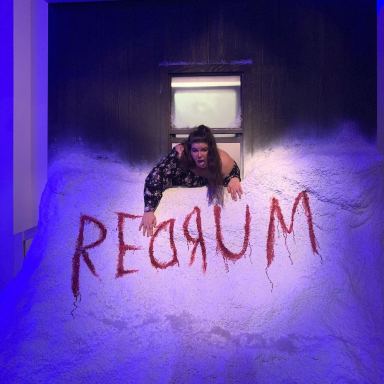Viking Movies: Roving Warriors From The Land Of The Midnight Sun
Here are the notworthy films that seek to convey the bloody and action-packed drama of the Viking Era to modern audiences.
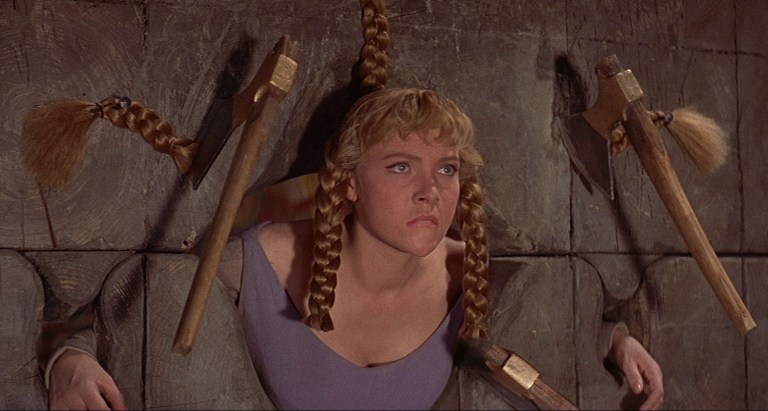
Table of Contents
Best/Good Viking Movies
Prince Valiant (1954)

The comic strip “Prince Valiant” was created by cartoonist Hal Foster in 1937, and as of 2022, it continues to run in several Sunday newspapers. Prince Valiant’s haircut is so distinctive—bangs in front, evenly neck-length on all sides—that it’s become known as the “Prince Valiant haircut.” This adventure film was based on the characters in the comic strip. It stars Robert Wagner in the title role as the son of the exiled King of Scandia, whose formerly Christian domain has been taken over by a pagan named Sligon (6’6” former professional Italian boxer Primo Carnera) with the help of the mysterious “Black Knight.” Prince Valiant has two goals: To reclaim Scandia and reestablish it as a Christian kingdom, and to become a confirmed Knight of the Round Table at Camelot. Prince Valiant was filmed in Technicolor and Cinemascope.
The Vikings (1958)
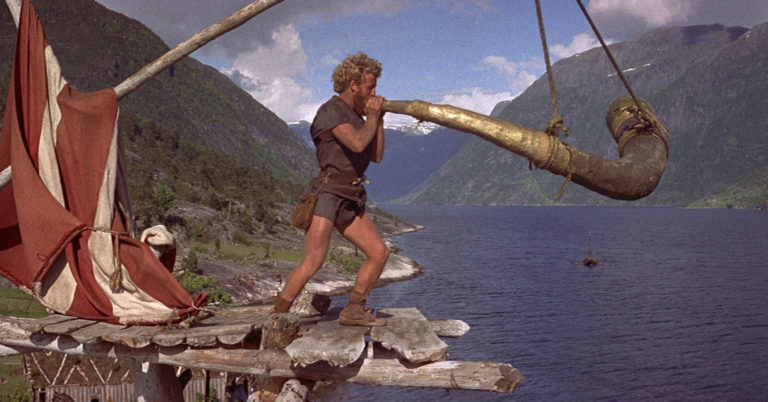
Einar (Kirk Douglas) and Eric (Tony Curtis) are half-brothers, but they don’t realize it. Einar is a great Viking warrior, and Eric is a former slave. When the king of Northumbria is overthrown, Einar and Eric fight one another to become the new king—and they also fight over who gets to claim the beautiful Princess Morgana (Janet Leigh) as his wife. (Ironically, Tony Curtis and Janet Leigh were married at the time of this film’s making, so the matter had already been settled.) Most of The Vikings was shot in Norway. DVD Talk writes, “If nothing else, this is a colorful and at times beautiful looking film….There’s the right mix of adventure, action, heroism, romance, drama and yes, even intrigue here….The Vikings is very much a grand adventure film in the old Hollywood tradition, made with a good budget, a talented crew and an A-list cast. It holds up well, mixing excitement, action, drama and romance together in equal doses and moving at a very fine pace.”
The Long Ships (1964)
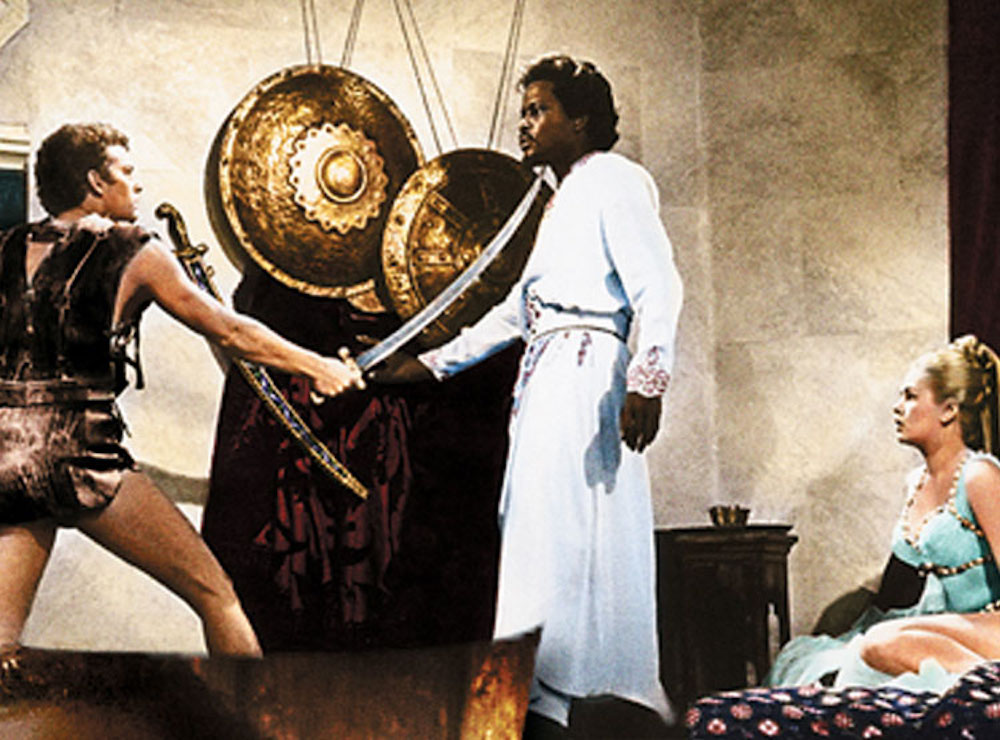
According to legend, somewhere on the Muslim-controlled Moorish coast, close to the Pillars of Hercules, lies the legendary “Mother of All Voices,” a giant golden bell the size of three men. A Viking sailor named Rolfe (veteran Hollywood actor Richard Widmark) and a Moorish king named Aly Manush (Sidney Poitier) are both obsessed with finding and owning the bell, which leads them to not-so-peacefully cross one another’s paths. One of the most memorable features of The Long Ships is a torture device known as the “Mare of Steel”—it’s a gigantic curved blade on which the condemned are made to ride on, hands tied behind their backs and their bellies exposed to the blade, all the way down to the ground, where they are then impaled on a bed of steel spikes. Digitally Obsessed portrays the film as an artistic disaster: “In the end, The Long Ships is not really fit for anyone above the age of 12. I can’t even recommend a rental because, let’s face it…life is too short.”
Knives Of The Avenger (1966)
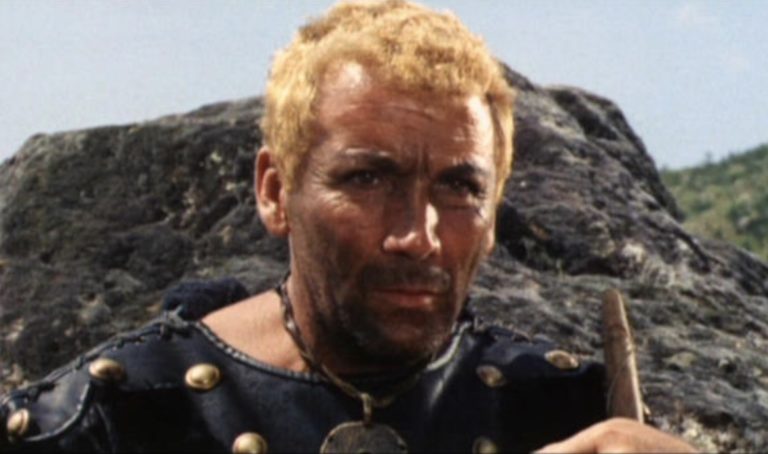
This is the second Viking movie by legendary Italian horror director Mario Bava (the first was 1961’s Erik the Conqueror) and was released in Italy as I costello del vendicatore. Set in the 800s, it tells the story of a Viking peasant woman named Karin (Elisa Pichelli), who is mourning the presumed death of her husband, King Arald (Giacomo Rossi-Stuart), but still hopes that one day he will return to care for her and their young son Moki (Luciano Polletin). In Arald’s absence, an evil local warlord named Aghen (Fausto Tozzi) seeks, against her wishes, to make her his concubine. A mysterious but also hauntingly familiar stranger named Rurik (Cameron Mitchell), whose warrior specialty is to throw knives at his opponents, develops a protective fondness for Karin and her son—but at least for the time being, Karin doesn’t remember that he is King Rurik, a brutal warrior who once plundered her village and raped her.
Several observers have noted that Knives of the Avenger is simply a Viking rendering of the plot of the classic western movie Shane (1953), right down to a barroom brawl scene which reenacts the same scene in Shane right down to the lighting. The Spinning Image writes, “It may fall short of the mythic grandeur attained by its model Shane, but this remains a solid B picture and a compelling work.”
Alfred the Great (1969)
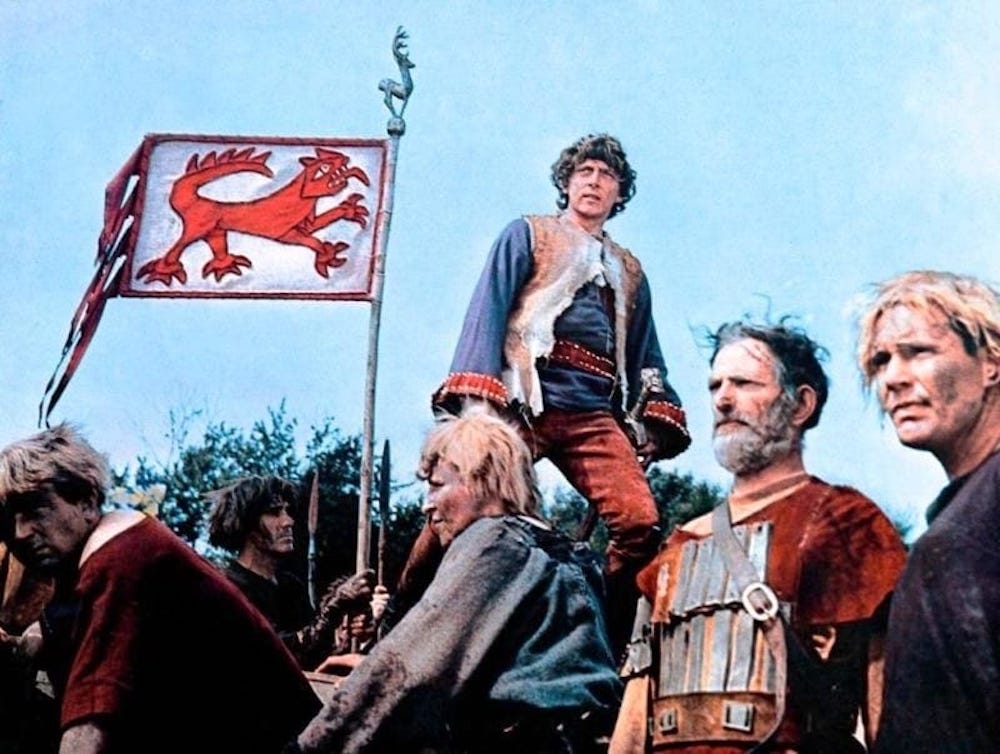
In the 800s, as the Christian population of Old England is being subjected to endless predatory ransacking by the Viking Danes, David Hemmings stars as Alfred, an Englishman who seeks to join the priesthood but also has a thirst for violence. He decides to put aside his spiritual aspirations for the moment and rally the forces to take up arms against the Viking invaders, who are led by Guthrum (Michael York). Time Out writes, “Much derided at the time, Donner’s shot at an intelligent epic is a little more sympathetic three decades on….The model was evidently Lawrence of Arabia, with Alfred (Hemmings) the flawed hero, wanting to be a good Christian but dismayed by his propensity for violence, while in mirror image, Guthrum the ‘savage pagan’ (York) finds love undermining his rape ‘n’ pillage ethos.”
The Norseman (1978)
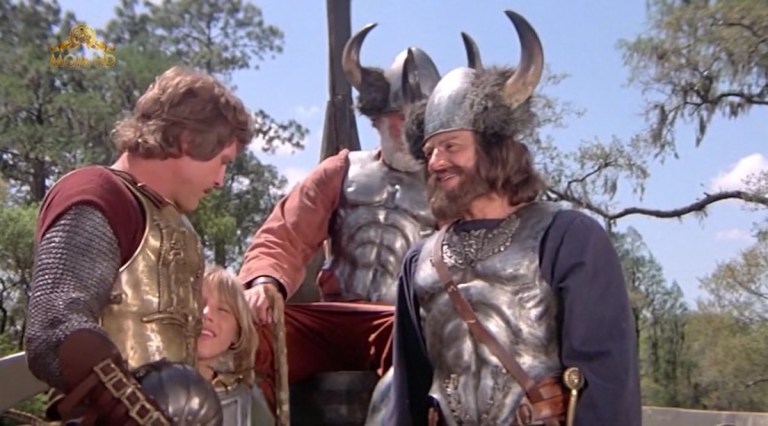
This is a low-budget oddity that stars Lee Majors, who’d gained fame in the 1970s as the half-cyborg protagonist of a TV show called The Six Million Dollar Man. In The Norseman, Majors stars as a Viking warrior named Thorvald the Bold. Thorvald seeks vengeance against a warring tribe of Native Americans who had blinded and enslaved his father during an earlier expedition into the New World. The Norseman was filmed in Tampa, FL, which is perhaps the least Nordic-looking locale on the planet. According to Majors, “I had a little time off, and they said, ‘It shoots in Florida, on the coast there, out of Tampa,’ and they had a bunch of Tampa Bay Buccaneers that were gonna play Vikings, so, I don’t know, I thought it’d be fun, so I did it.” The Washington Post writes, “Majors projects so little animal magnetism that one can’t help wondering how Thorvald became known as The Bold. His Southern accent is surely centuries ahead of its time….The only thing ‘The Norseman’ is good for is an occasional derisive laugh.”
Erik the Viking (1989)
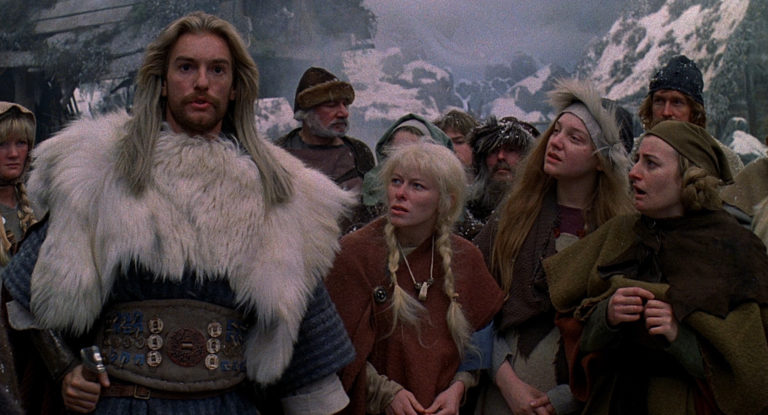
Written and directed by Monty Python member Terry Jones, Erik the Viking is a spoof of Nordic mythology in which Erik (Tim Robbins) is a more sensitive kind of Viking who really isn’t too keen on raping in and pillaging. Erik and his men scour the earth in an attempt to find Valhalla and ask the Norse gods to end the age of Ragnarok, only to find that Odin and his drinking buddies are disinterested and passive-aggressive. Python alum John Cleese is featured, as are Eartha Kitt and Mickey Rooney in supporting roles. Giving it zero stars, Roger Ebert savaged the film: “Every once in a while a movie comes along that makes me feel like a human dialysis machine. The film goes into my mind, which removes its impurities, and then it evaporates into thin air. ‘Erik the Viking’ is a movie like that, an utterly worthless exercise in waste and wretched excess, uninformed by the slightest spark of humor, wit or coherence.”
The 13th Warrior (1999)

Antonio Banderas plays Ahmed Ibn Fadlan, a Muslim emissary from Baghdad in the year 922 who is captured by Vikings and taken into their world. Although he originally finds them to be boorish and crude, he learns to admire the Vikings’ rowdiness and lust for life. Ahmed eventually teams up with a dozen other Vikings to help them fend off predatory roving gangs of cannibals. Although he is at heart a poet rather than a warrior, necessity forces him to quickly learns the arts of battle. The 13th Warrior is based on the 1974 novel Eaters of the Dead by Michael Chrichton, who is perhaps best known as the author of the novel Jurassic Park. Roger Ebert writes, “With a budget said to be more than $100 million, it displays a lot of cash on the screen, but little thought. The film seems to have been conceived from the special effects on down. Instead of beginning with a good story and then adding f/x as needed, it apparently began with f/x and then the story was shoehorned into the pauses in the action.”
Beowulf (2007)
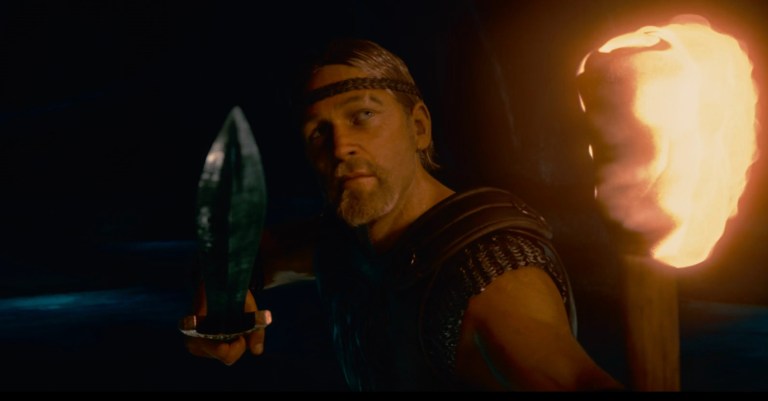
The word “Beowulf” is a rendering of the ancient Anglo-Saxon word for “Bear,” and the epic poem Beowulf, thought to have been written somewhere around 700AD, is considered the oldest known written story in the language that eventually became modern English. In this film by director Robert Zemeckis (Back to the Future), Ray Winstone stars in the title role as a legendarily indomitable hero who emerges from the sea to fight the evil Grendel (Crispin Glover), a savage troll who invaded the mead hall of Danish King Hrothgar (Anthony Hopkins) to murder and eat the king’s warriors. In the course of his mission, Beowulf is enticed into the lair of Grendel’s highly seductive mother, who is played by Angelina Jolie.
Pathfinder (2007)
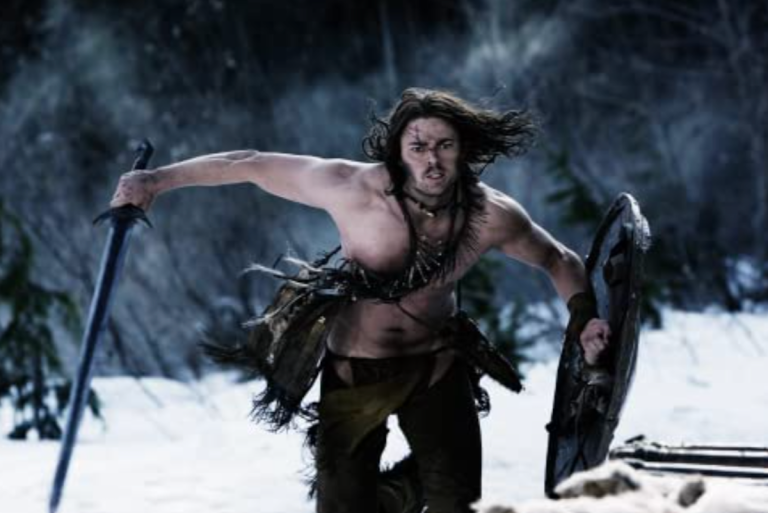
Set in Newfoundland, which is one of the parts of North America that Viking invaders successfully settled for a time long before Christopher Columbus was born, Pathfinder tells the tale of a young boy who was abandoned and left behind by his Viking father when he refused to battle the indigenous Americans, only to be adopted by the tribe, given the name Ghost, and become a fierce defender of their culture and land. Reel Views writes, “Pathfinder feels like one of those generic ’80s action films where there’s plenty of violence with no suspense, lots of stunt work but no excitement, and a cast of characters so poorly developed that it’s easier to care about the background scenery….Pathfinder wants to provide a jolt of adrenaline; ironically, it works better as a tranquilizer.”
Pathfinder is based on the 1987 Norwegian film Veiviseren by director Nils Gaup, who, after watching the American remake, said, “Twice Hollywood has remade my films, and both times they have managed to make the worst movie ever.”
Thor (2011)
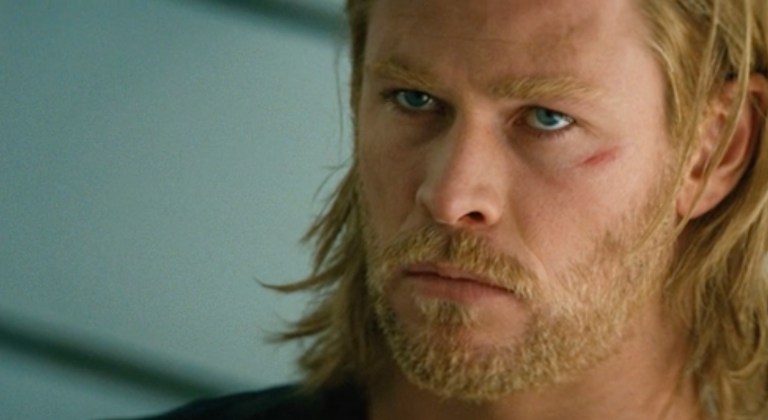
In Norse mythology, Thor is the warrior son of the god Odin. He wages battle by swinging his fearsome hammer, Mjolnir. In this screen adaptation of Thor’s legend by director Kenneth Branagh, Odin (Anthony Hopkins) banishes the ambitious and strong-willed Thor (Chris Hemsworth) from the heavenly realm of Asgard for his arrogance. Thor lands in modern New Mexico, understandably disoriented and confused. He is found stumbling through the desert by a trio of scientists played by Natalie Portman, Kat Dennings, and Erik Selvig. As he gradually regains his confidence and his hammer-swinging abilities, Thor finds he will need them, because dark forces are invading Earth from his former homeland. Reel Views writes, “Those satisfied with an understanding of the complex mythology surrounding the character, coupled with the entertaining ‘fish out of water’ that results from a God wandering around 21st century America, may be delighted. Branagh’s Thor is big enough and bold enough to fit under the Marvel umbrella but infused with sufficient uniqueness to make it work for those weary of generic superhero stories.”
Hammer of the Gods (2013)
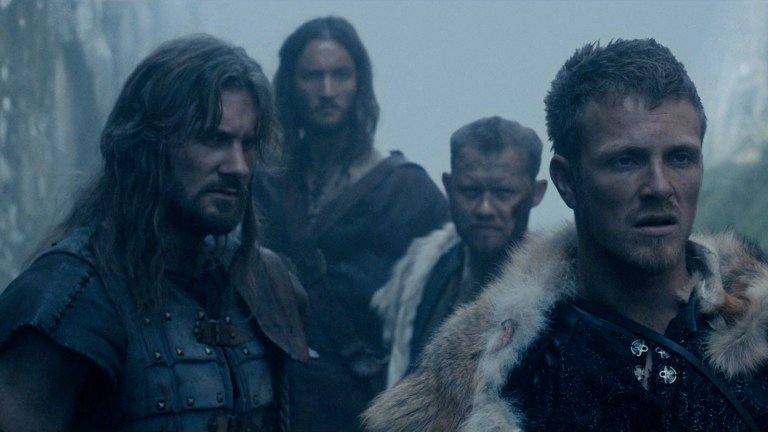
Set in England in 870AD, Hammer of the Gods finds the Vikings, led by King Bagsecg (James Cosmo), making war with the brutal and well-organized Saxons. When the king is severely wounded during battle while attempting to stave off an encroaching battalion of Saxons, he sends his son Prince Steinar (Charley Bewley) on a mission to find his long-lost brother, Hakan the Ferocious (Elliot Cowan), in a quest to defeat the Saxons, preserve the Viking clan, install Hakan as the new king. Horror News writes, “At its core, the plot of Hammer of the Gods is no more than a quest film where the king sends his most deserving son off on a journey to recover a more ferocious force to save the clan….But, just below the surface, is a subtext that is far more interesting and satisfying, the personal journey of Steinar….Oddly, it becomes a Viking coming of age film.”
Northmen: A Viking Saga (2014)
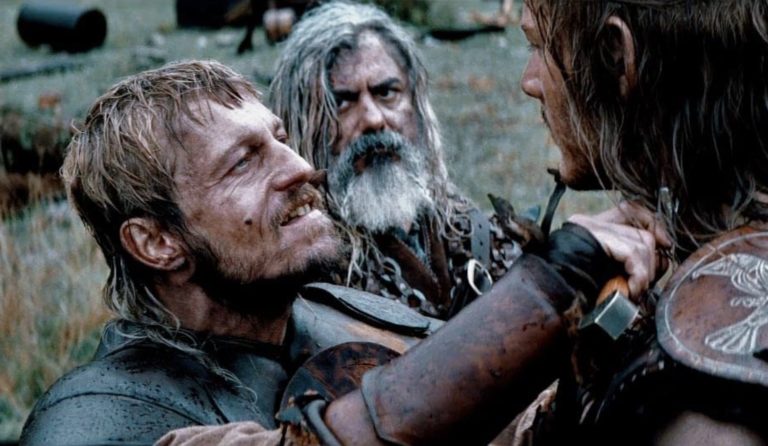
Filmed mostly in the decidedly non-Viking climes of South Africa, Northmen tells the tale of a band of Vikings whose wrecked ship leaves them stranded on the Scottish coast, where the King of Alba has dispatched forces to kill them all down to the last man. If they have a chance of surviving, it would require finding the Viking settlement of Danelagh, but they will need to cross unfamiliar and hostile terrain to get there. Along the way, they meet up with an unlikely ally—a Christian monk who is deadly with his sword. As they set traps en route to Danelagh, it becomes a race of time where only one side will win—or possibly neither.
Viking Quest (2015)
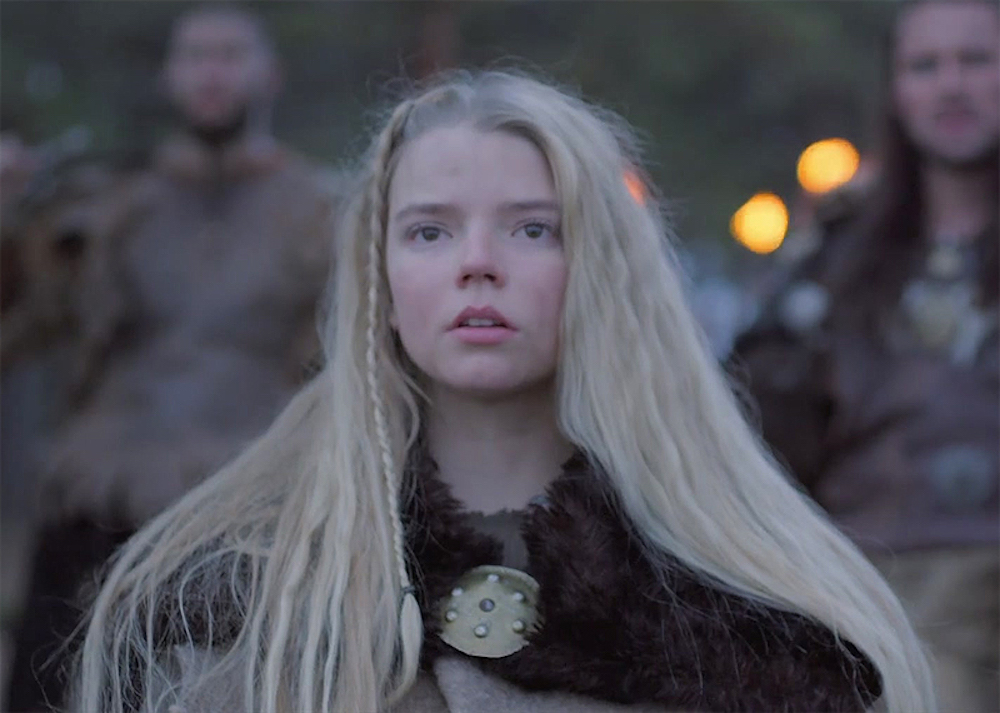
In this low-budget offering from the SyFy channel, a young peasant boy hamed Erick (Harry Lister Smith) is kidnapped from his home by rampaging Vikings, who take him into their fold and raise him as one of their own. In their quest to rescue their kidnapped princess from the legendarily fearsome Midgard Serpent, they get attacked by the giant reptile and are forced to fulfill an ancient prophecy that says they will battle the dragons. But in so doing, they may trigger Ragnarok—the end of the world. World of Film Geek writes, “The battle scenes for this film are beyond great for this historical epic. There are loads of axes swinging, arrows flying, and swords blazing in the wintery landscapes of Norway.”
The Last King (2016)
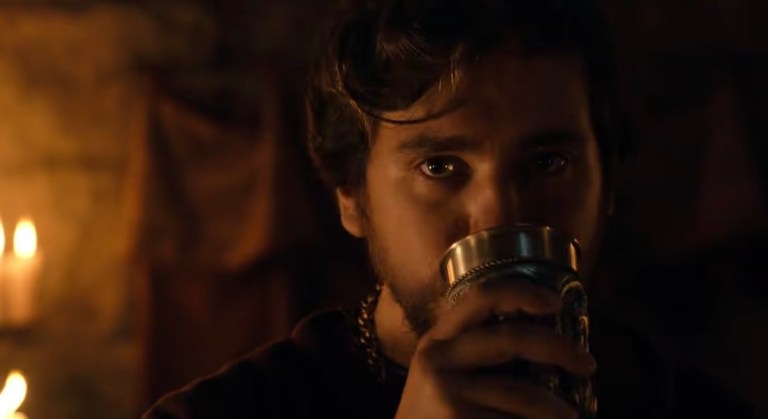
Norwegian director Nils Gaup—who directed the original version of Pathfinder in 1987—dives deep into his country’s history for this film that tells the true story of Norways’s King Hakon IV (1204-1263). At age two while the nation was plunged into a civil war, Hakon was the illegitimate infant son of Norway’s king, and since he was an heir to the throne, he was marked for death by the half of the population that wanted to overthrow the king. Two of the king’s loyal soldiers sweep Hakan away from danger and guard him in secrecy so that he can legally assume the throne when his father dies.
Viking (2016)

Set in Kievan Rus—a huge swath of land in Eastern Europe whose capital was Novgorod and which is now occupied by the modern nations of Russia, Belarus, and Ukraine—Viking is a Russian production that tells the story of young Viking prince Vladimir of Novgorod, who was forced to flee into Scandinavia after one of his brothers murdered another one of his brothers and assumed control of Rus. Viking took six years to make, and with a budget of about $21 million, its was at the time the third most-expensive Russian film ever made. It also became 2016’s top-grossing Russian film.
Redbad (2018)
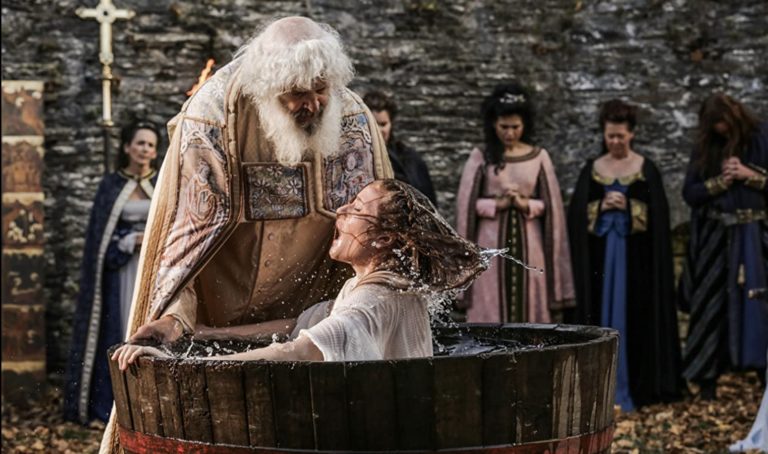
Although it is superficially about the power struggle between the Frisian Redbad and Pepin of Herstal, Lord of the Franks, the larger clash here is the ongoing attempt of Christians to use their religion as a weapon to vanquish Europe’s indigenous pagan populations. Redbad is set in 700AD in Northern Europe, which is essentially divided into two cultures: The pagan Frisians, Saxons, and Danes who lived above the rivers, and the Christian Franks who lived to the south. World of Film Geek describes Redbad as “a nearly three-hour epic about a war involving religion that looks to be described as Game of Thrones meets Vikings.” Described as “likely the biggest box-office bomb in Dutch movie history,” Redbad made back only 300,000 euros on a budget of 8 million euros and moved to a video-on-demand format only seven weeks after its theatrical release.
The Northman (2022)

From director Robert Eggers, who cowrote the script with Icelandic poet Sjon, comes this lavishly violent adaptation of the legend of Amleth (Alexander Skarsgård), a young prince who goes into exile in the year 914AD after his father is murdered by his uncle, who then usurps the kingdom and marries Amleth’s mother, Queen Gudrun (Nicole Kidman). Amleth flees Iceland via boat and is trained in the ruthlessly martial ways of Viking berserkers. He meets and falls in love with a Slavic slave-woman (Anya Taylor-Joy), and together they return to Iceland seeking justice. Eggers worked with several historians to make pre-Christian Iceland as authentic as possible. Neil Price, an archeologist at Uppsala University in Sweden, said that the film “might be the most accurate Viking film ever made.”
More Viking Movies

- Erik the Conqueror (1961) seeking to capitalize on the success of 1958’s The Vikings, Italian director Mario Bava spins this colorful tale of war between Vikings and Saxons along the British coast in the late 700s.
- The Last of the Vikings (1961) released in Italy as L’ultimo dei Vikinghi, this film tells the story of two brothers (Cameron Mitchell and Edmund Purdum) who return to Norway only to find that their father—the king—has been murdered.
- Erik the Viking (1965) as Viking explorers head to the New World, they encounter unimaginable resistance—not the least of which involves Native Americans who are fully ready to wage war against them.
- The Viking Queen (1967) Queen Salina (an actress known only as “Carita”) seeks to appease her father’s last wish by sharing power with a Roman named Justinian, a move which displeases both the Romans and the indigenous Druids.
- The Littlest Viking (1989) released in Norway as Sigurd Drakedreper, this Norwegian production traces the efforts of a Viking boy to mature into a fearsome and trustworthy warrior.
- The Viking Sagas (1995) Kjartan (Ralf Moeller) is a relentless warrior who travels over the brutal terrain of the land of ice, snow, and the midnight sun to avenge all intruders and preserve his people’s culture.
- The 13th Warrior (1999) based on Michael Crichton’s novel “Eaters of the Dead., the film stars Antonio Banderas as an Arab traveler named Ahmed Ibn Fadlan, who joins a group of Viking warriors to defend a village from mysterious, bear-like creatures called Wendol.
- Ancient Tale: When the Sun Was A God (2003) in this Polish production originally released as Stara basn. Kiedy slonce bylo bogiem, a brutal ruler oppresses the pagan Slavs, who decided to join forces and overthrow him.
- Dark Kingdom (2004) is a German TV production based on the Norse myth of Siegfried the Dragon Slayer and set during the era where many European pagans were converting to Christianity.
- Beowulf and Grendel (2005) this Swedish production whose subtitle was Beneath the Legend Lies the Tale is a spin on the Beowulf legend in which the monstrous Grendel vows revenge against the Danish king who killed his father.
- Severed Way (2007) Stranded and left for dead in North America after their band was attacked and mostly slaughtered, two Norsemen part ways and fight for survival.
- Outlander (2008) along with a monster known as the Moorwen, a space alien crash-lands in Scandinavia but offers to team up with the Vikings to slay the Moorwen.
- Valhalla Rising (2009) a fighting pagan warrior escapes from slavery and joins the Christians during their Crusades to beat back the Muslims and reconquer the Holy Land.
- Vicky the Viking (2009) in this engaging children’s comedy, “Vicky” is a young Viking boy who his smarter than he is strong. One day he decides to join the elder Viking males as they set out for adventure and trouble on the high seas.
- How to Train Your Dragon (2010) this animated 3D kids’ adventure film traces the story of a young boy who aspires to be a dragon hunter but changes his mind when he finally befriends a real-life dragon.
- Escape (2012) a decade after the Black Plague has ravaged most of Europe, a young girl is kidnapped by a roving gang of Vikings and must plot a way to escape what is sure to become a brutal and unforgiving existence for her.
Vikings in History
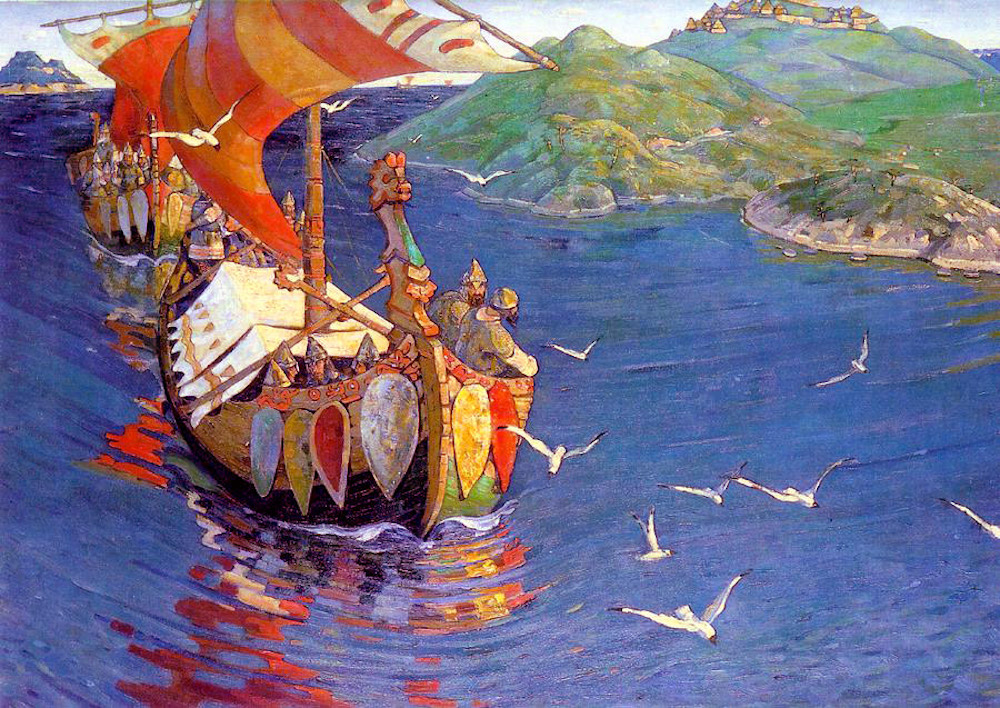
According to modern popular culture, the Vikings were bloodthirsty, rapacious pagan brutes who terrorized and brutalized the British Isles, continental Europe, and even parts of North America from the late 700s to the late 1000s AD.
While this is mostly true, it tends to trivialize the fact that Nordic culture was not entirely primitive and that it gave rise to its own culture, tools, languages, and even a religious system known as Odinism that is described in scriptures known as the Poetic Eddas. The Vikings’ descendants would also go on to found what are now some of Europe’s most highly developed nations.
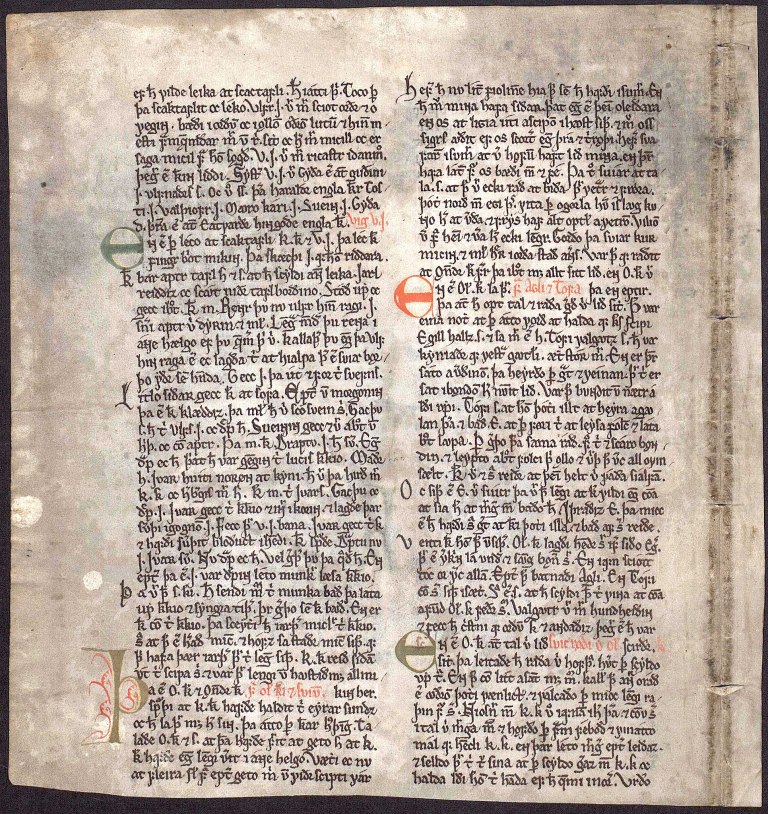
There are several theories for why Vikings began raiding other countries during that time. One is that as a polygynous culture—where each man had several female partners—they were merely attempting to replenish a waning supply of available women. Another is that the Saxons to the south of them had been weakened, leading the Vikings to attempt an expansion of their own power and thus fill the new vacuum.
The most plausible explanation is that Christianity was spreading rapidly through Europe—often by force. After French King Charlemagne was shown to have “used force and terror to Christianize all pagans,” Viking clans chose to strike out in a preemptive manner. The terror that they wrought during the “Viking Era” is still the stuff of rich mythology throughout the world.
Eventually, though, Christianity won out. The formerly pagan enclaves of far northern Europe became converted and, some would say, domesticated as a result of Christianity. What were once the unorganized and wild lands of the Vikings are now the modern countries of Sweden, Norway, and Denmark.
